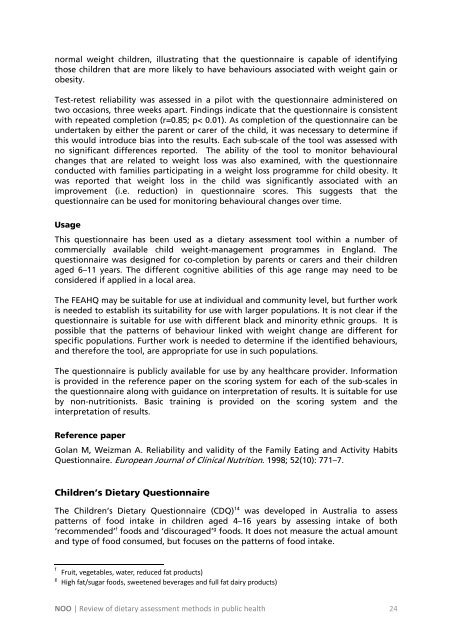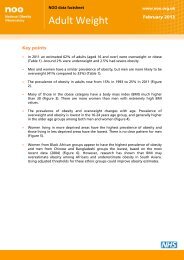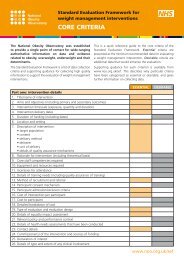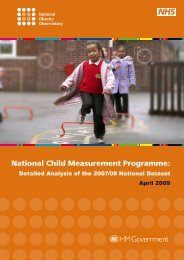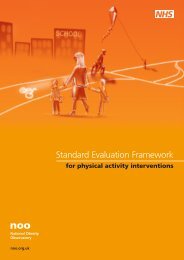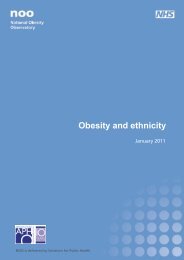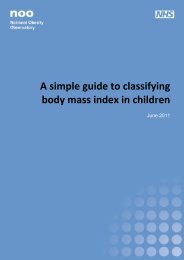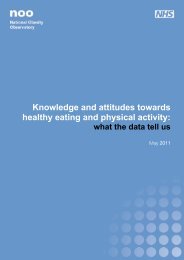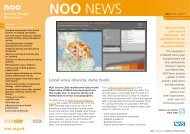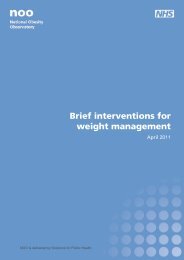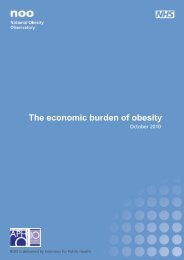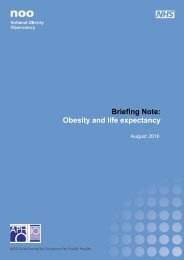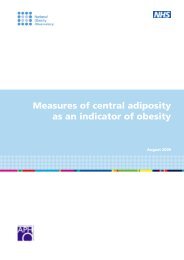Review of dietary assessment methods in public health - National ...
Review of dietary assessment methods in public health - National ...
Review of dietary assessment methods in public health - National ...
You also want an ePaper? Increase the reach of your titles
YUMPU automatically turns print PDFs into web optimized ePapers that Google loves.
normal weight children, illustrat<strong>in</strong>g that the questionnaire is capable <strong>of</strong> identify<strong>in</strong>gthose children that are more likely to have behaviours associated with weight ga<strong>in</strong> orobesity.Test-retest reliability was assessed <strong>in</strong> a pilot with the questionnaire adm<strong>in</strong>istered ontwo occasions, three weeks apart. F<strong>in</strong>d<strong>in</strong>gs <strong>in</strong>dicate that the questionnaire is consistentwith repeated completion (r=0.85; p< 0.01). As completion <strong>of</strong> the questionnaire can beundertaken by either the parent or carer <strong>of</strong> the child, it was necessary to determ<strong>in</strong>e ifthis would <strong>in</strong>troduce bias <strong>in</strong>to the results. Each sub-scale <strong>of</strong> the tool was assessed withno significant differences reported. The ability <strong>of</strong> the tool to monitor behaviouralchanges that are related to weight loss was also exam<strong>in</strong>ed, with the questionnaireconducted with families participat<strong>in</strong>g <strong>in</strong> a weight loss programme for child obesity. Itwas reported that weight loss <strong>in</strong> the child was significantly associated with animprovement (i.e. reduction) <strong>in</strong> questionnaire scores. This suggests that thequestionnaire can be used for monitor<strong>in</strong>g behavioural changes over time.UsageThis questionnaire has been used as a <strong>dietary</strong> <strong>assessment</strong> tool with<strong>in</strong> a number <strong>of</strong>commercially available child weight-management programmes <strong>in</strong> England. Thequestionnaire was designed for co-completion by parents or carers and their childrenaged 6–11 years. The different cognitive abilities <strong>of</strong> this age range may need to beconsidered if applied <strong>in</strong> a local area.The FEAHQ may be suitable for use at <strong>in</strong>dividual and community level, but further workis needed to establish its suitability for use with larger populations. It is not clear if thequestionnaire is suitable for use with different black and m<strong>in</strong>ority ethnic groups. It ispossible that the patterns <strong>of</strong> behaviour l<strong>in</strong>ked with weight change are different forspecific populations. Further work is needed to determ<strong>in</strong>e if the identified behaviours,and therefore the tool, are appropriate for use <strong>in</strong> such populations.The questionnaire is <strong>public</strong>ly available for use by any <strong>health</strong>care provider. Informationis provided <strong>in</strong> the reference paper on the scor<strong>in</strong>g system for each <strong>of</strong> the sub-scales <strong>in</strong>the questionnaire along with guidance on <strong>in</strong>terpretation <strong>of</strong> results. It is suitable for useby non-nutritionists. Basic tra<strong>in</strong><strong>in</strong>g is provided on the scor<strong>in</strong>g system and the<strong>in</strong>terpretation <strong>of</strong> results.Reference paperGolan M, Weizman A. Reliability and validity <strong>of</strong> the Family Eat<strong>in</strong>g and Activity HabitsQuestionnaire. European Journal <strong>of</strong> Cl<strong>in</strong>ical Nutrition. 1998; 52(10): 771–7.Children’s Dietary QuestionnaireThe Children’s Dietary Questionnaire (CDQ) 14 was developed <strong>in</strong> Australia to assesspatterns <strong>of</strong> food <strong>in</strong>take <strong>in</strong> children aged 4–16 years by assess<strong>in</strong>g <strong>in</strong>take <strong>of</strong> both‘recommended’ f foods and ‘discouraged’ g foods. It does not measure the actual amountand type <strong>of</strong> food consumed, but focuses on the patterns <strong>of</strong> food <strong>in</strong>take.fgFruit, vegetables, water, reduced fat products)High fat/sugar foods, sweetened beverages and full fat dairy products)NOO | <strong>Review</strong> <strong>of</strong> <strong>dietary</strong> <strong>assessment</strong> <strong>methods</strong> <strong>in</strong> <strong>public</strong> <strong>health</strong> 24


